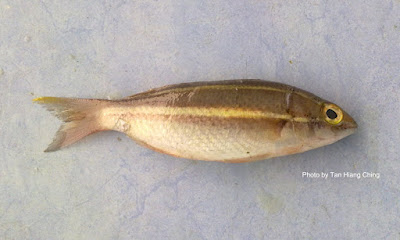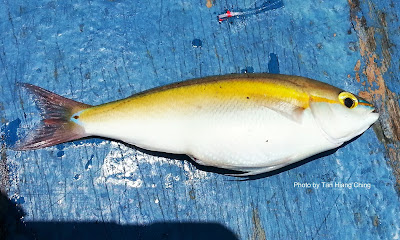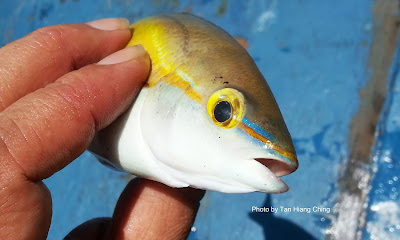Breams (Whiptails)
Overview
Species of the Nemipteridae family are found mainly in tropical and subtropical waters of the Indo-West Pacific. They are distinguished by having a single continuous dorsal fin, with 10 spines and 9 soft rays, and anal fin with 3 spines and 7 to 8 soft rays. Their colours are extremely variable, but often pinkish or reddish with red, yellow or blue markings.Nemipterids are carnivorous bottom-living fishes feeding mainly on other small fishes, cephalopods, crustaceans, and polychaetes. They can be solitary or schooling and do not appear to be territorial.
Whiptails or Pentapodus are distinguished from other nemipterids by having 2 to 3 pairs of small canines teeth anteriorly in upper jaw, a single pair of larger, flared canines teeth anteriorly on either side of lower jaw. Their body depth are 3 to 3.5 times in standard length.
Common Whiptail Breams Species
Scientific Name: Pentapodus bifasciatus (Bleeker, 1848)
English Name: White Shouldered Whiptail
Malay Name | Nama Melayu Malaysia: Anjang-anjang Dua Jalur
Main Identification Features: Upper body brown and white on ventral surface. Two white horizontal stripe at the side of body and a thin stripe close to dorsal fin. Caudal fin lobes pointed; not falcate.
Size: Maximum standard length 15 cm, commonly to 10 cm.
Habitat and Ecology: Shallow coral reefs, to 20 m depth. Occurs solitary or in groups. Feeds mainly on small fishes, crustaceans, and polychaetes.

Scientific Name: Pentapodus setosus (Valenciennes, 1830)
English Name: Butterfly Whiptail
Malay Name | Nama Melayu Malaysia: Anjang-anjang Monofilamen
Thai Name | ชื่อสามัญภาษาไทย: ปลาสายรุ้ง (Plā s̄āyrûng)
Main Identification Features: Presence of two bluish stripes across snout, first from middle of eye to tip of snout, second from upper lip to lower margin of eye. Presence of a black spot on upper caudal peduncle.
Size: Maximum standard length 17.5 cm, commonly to 15 cm.
Habitat and Ecology: Soft bottoms close to reefs, 5 to 50 m depth. Occurs in groups. Feeds mainly on small crustaceans.


